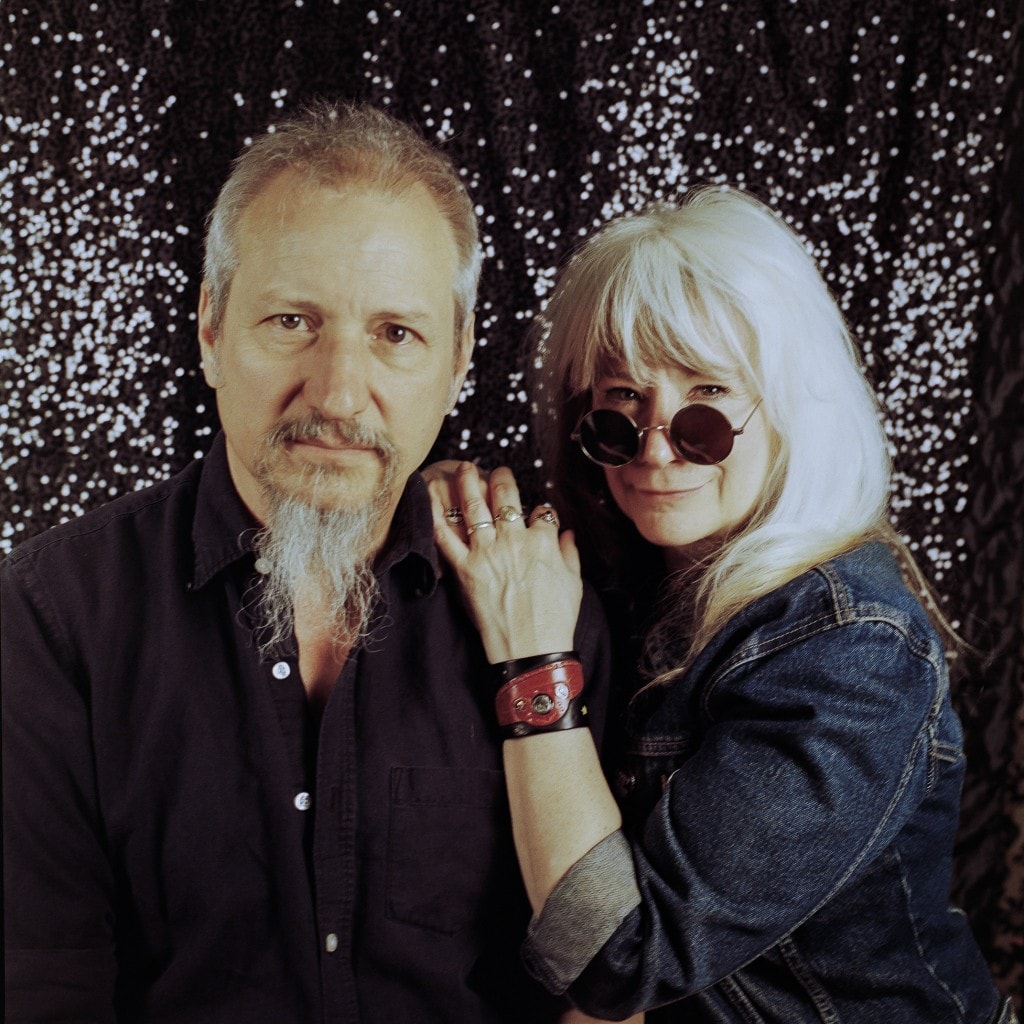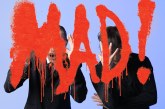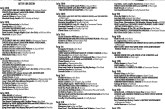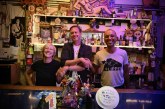Over the course of their prolific career, Bark — the alter ego of Tim Lee and Susan Bauer Lee — have successfully used their minimalist trappings to fully advantage, creating a sound that’s creative, compelling, durable and dynamic. After a year that found them each dealing with a loss of a parent and confronting mortality in often unexpected ways, it’s little wonder that their evocative new album, Terminal Everything, is their most expressive effort yet. It’s also evidence of continued growth, confidence and cohesion, elements that are in ample abundance throughout. On the surface, their sound may be minimal, given that the arrangements rely on Tim’s visceral guitar play and Susan’s steady drums, but it’s both moving and compelling as well. It’s little wonder that Bark have drawn such a loyal fan base and attained a reputation as one of the of most singularly popular combos in all of East Tennessee.
Blank recently sat down with Bark and asked them to share some insights about the new album.
It’s evident in the tone and treatment that the losses you both suffered translated to the new album, even down to the title Terminal Everything. How exactly did the events of the past year impact your efforts?
Tim: Those losses, along with others, are very much the most prominent subject matter of this group of songs. For me, losing someone as influential and close as my mom led to some soul searching. As a guy who’s written songs for years, I figured that was an obvious device for dealing with all of this. Before I moved forward with it, I knew it was important to put myself into my contributions, not take a detached viewpoint. There were very few punches pulled.
Does the fact that you’re a duo ever make you feel musically constricted, or, to the contrary, does it give you a greater sense of freedom and expression?
Tim: There’s some of both, but I think the greater freedom outweighs the constrictions. We’ve also changed our approach — I like to think of it as a progression — over the past few years. Originally, we tried to write songs specifically for the two-piece setup. But now, we just write the songs without much thought of that and figure out how to make them work with the duo. I’m a big fan of leaving open space in music, so this particular combination offers many opportunities to scratch that itch.
Can you give us some insight into how you write the two of you write and arrange your songs? Is it a collaborative effort?
Tim: There’s no set method. Sometimes one of us has an idea that the other takes and expounds on. Sometimes, one of us brings in something that is basically complete. Songs can happen in a variety of ways. The arrangement part is definitely a collaboration. With the new record, we made the conscious decision to put a little more time into the arrangements, and to let the songs kinda find their own arrangements, rather than try to make them fit some preconceived format. A good example of that is the song “Home,” which I brought in with just a barebones of an idea. We rehearsed a verse or two and a chorus for a couple weeks before we figured out where it needed to go lyrically. After playing it for a while, one day we just had a ‘aha’ moment, when the rest of the song revealed itself.
How do you see the new album fitting into Bark’s overall trajectory at this point? What does this album mean to you personally and professionally?
Tim: I think this record is a big step forward for us, in that I feel like we’ve figured out how to be a two-piece band in the studio. We’ve been good with the live thing for a while, and our recordings have been fine, but it seems like we really found our niche in the studio on this one. We still record our parts “live” in the studio, but we’ve figured out how much we are comfortable adding to that. On a personal level, I think it’s the best thing I’ve ever done, and for several reasons. It is an intensely personal record, but I like to think that people can relate to that. The songs have been getting a great reaction when we play them live, so maybe I’m right.
When and where was the album recorded? Who else played a role in the making of the album?
Tim: We did the tracking over two weekends in late 2018 and mixed it in a few days in early ’19. We recorded it all here in Knoxville at Top Hat Studio with John Harvey and Mary Podio. John’s microphone choices and placements, and the actual physical space for tracking at Top Hat, had a big influence on the way this record turned out. He has a really good knack for that, and so he tends to capture your sounds very naturally. I took a bigger role in “producing” than I usually do — which just means I spent some time screwing some sounds up on purpose — and John and I mixed it together. We couldn’t be happier with the results.
Did you bring in any outside contributors?
Tim: We did three songs as collaborations with local artists we dig and respect. Josh Wright, who I play with in Whole Wizard, brought in his homemade baritone lap steel and played on “Big Ol’ Party.” We gave Black Atticus a copy of the track for “Apocalypse Shimmy,” a cover song by some friends of ours from Mississippi called Liver Mousse. He showed up at the studio, sat down and wrote for about 45 minutes and then knocked out his rhymes in one take.
We did a similar thing with Mike Baggetta on “Chimneyville.” He worked out several ideas for guitar and electronics and showed up prepared to do his parts quickly. He did five tracks and had very definite ideas how to use them, all of which were perfect. Beyond that, Mary played percussion on several songs and sang along with Susan on a couple. They sing together well, and have done this on other recordings.
Will you be touring in support of the record? Venturing into new terrain?
Tim: Yeah, we’ve already been out playing and pimping the record. It’s been going quite well. We’re playing around the south right now, but we’ll venture out more in the fall. We’re doing a few West Coast dates in September, and a Northeast run in October. Basically, we’ll go anywhere that’ll have us.
Out of curiosity, does the music scene in and around Knoxville have any direct impact on the music you make? Or sway you in any particular direction?
Tim: Not specifically, but we certainly have artist friends here who we admire and respect. I guess we’ve been doing this long enough that nothing is really a direct influence any more; everything you’ve heard and dig all just gets mixed up and hopefully turns into something of your own. Besides, I’m not a fan of genres; I just dig art and music. Pigeonholing it takes the fun out of it for me.
Who are you currently grooving to?
Tim: M’dou Moctar, a guitarist/singer from Niger, stays on our turntable a lot lately. The stack next to the stereo right now includes blues folks like Super Chikan, Jesse Mae Hemphill, and Asey Payton, along with Professor Longhair, Mike Baggetta’s latest, Jim Dickinson, Feelies, Obnox, Funkadelic, Teardrop City, Thee Tsunamis, Cedric Burnside, The Great Dying, Thomas Jefferson Slave Apartments, and Gary Numan.
Where did the title of the album come from?
Susan Lee: The album title came from a sign in the parking lot of Public House. I had it in my mind years ago to use Terminal Everything for something well before this record came about, but it was the perfect title for the record we made.
The artwork on the new album is really unique. It definitely reflects the fact that you took some extra effort in its design and execution.
Tim: We’re really proud of this recording, but a whole other aspect of this album is the artwork. Susan had a vision for a hand-printed cover, which she was able to make a very cool reality.
Susan: Normally the images on all of our releases by both Bark and the earlier albums by the Tim Lee have been photographs, with the exception of the painting by Maggie Brannon that graced the first Bark EP. With Terminal Everything, it was the first time I saw something special in my mind and, with the help of Sarah Shebaro and Bryan Baker at Striped Light Letterpress, was able to execute all the steps to make it happen. I had never done anything like this before — cutting linoleum, setting type, and letterpress printing. Sarah helped with the linoleum blocks, typesetting and printing, and I am forever indebted to her for her support throughut every step in the process. Each cover is a piece of art, in and of itself, before you even get to the content, and that’s a concept that Jason Boardman and Striped Light Records encourages, that is, to allow the artist to have her/his hands in the entire process. And Striped Light Letterpress is a fantastic resource to make that happen. It was the most labor intensive thing I’ve ever done, and it was one of the most creatively fulfilling things I’ve done, besides songwriting and recording. I will do it again in a heartbeat.








